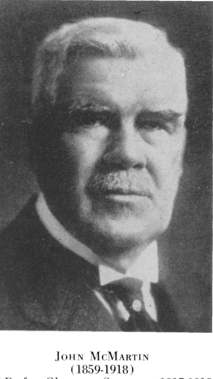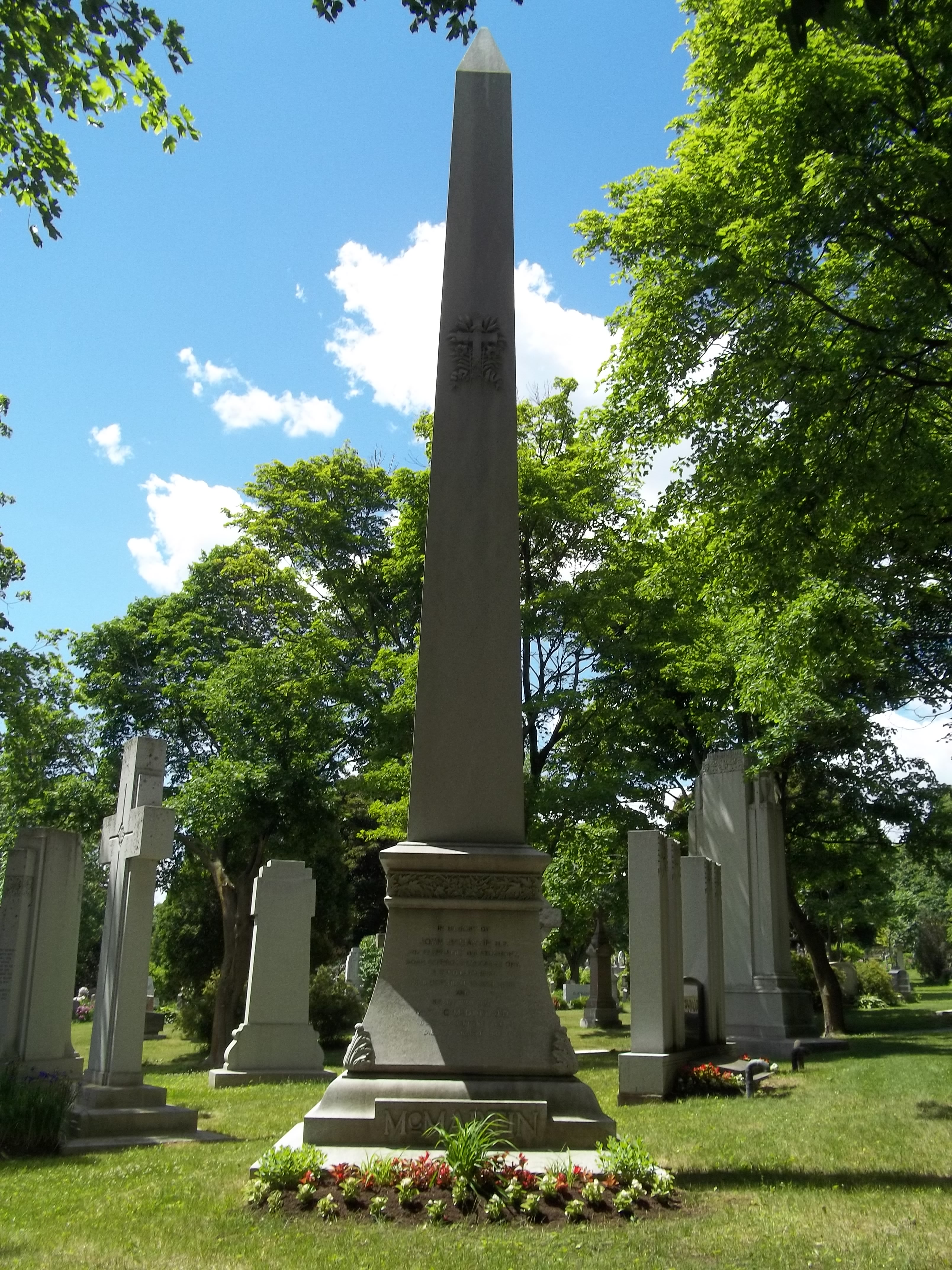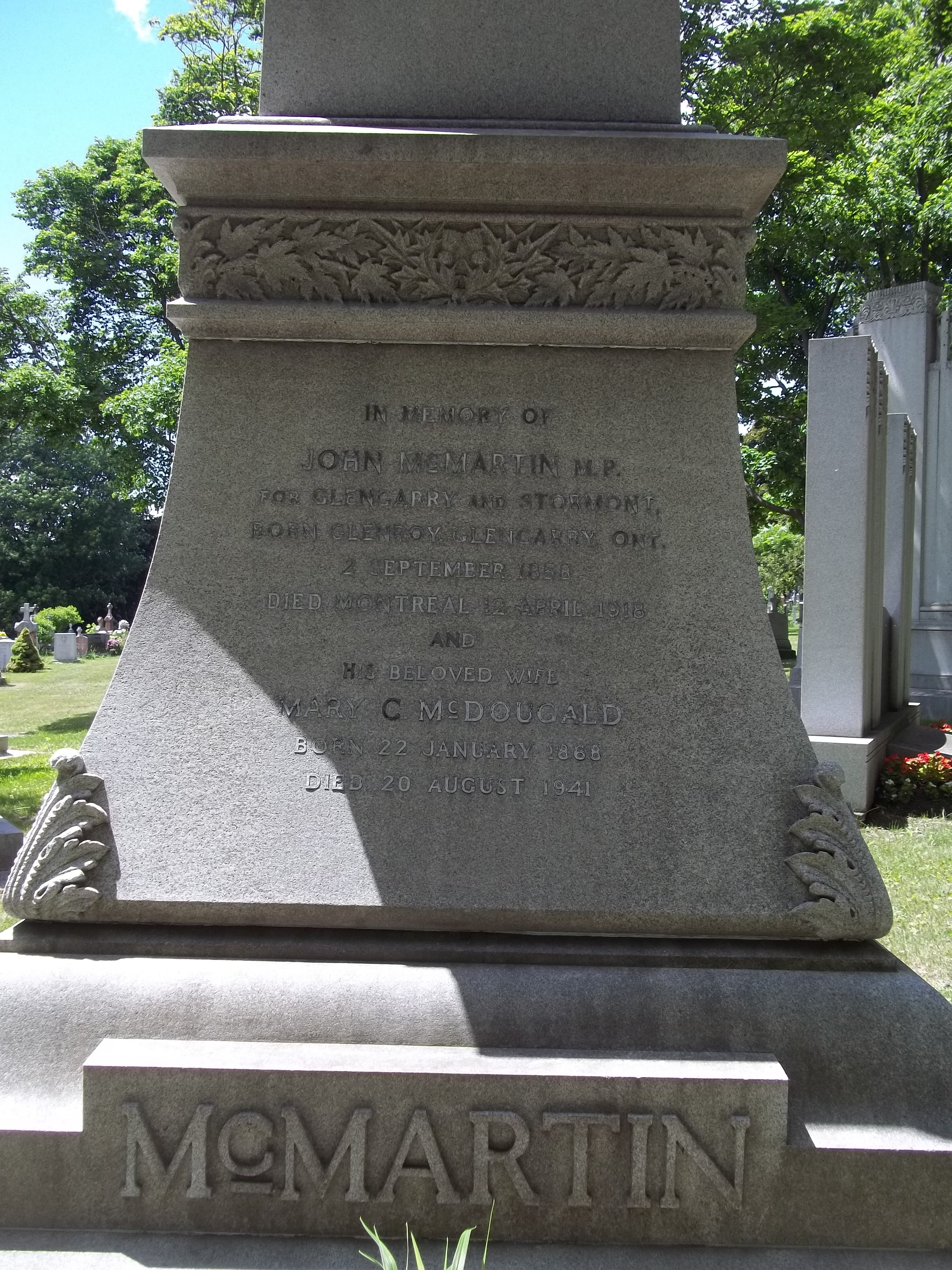"John McMartin was a highly respected member of Glengarry's Scottish community and rose to national prominence with his business, charitable and political dealings. He was a product of the 19th century explosion in development and exploitation of the vast mineral resources of the Canadian wilderness.
Born in Charlottenburg Twp, Glengarry,(Stormont) into a UEL founding family. His Cameron. McMartin and McDonald ancestors came to America from Scotland during the 18th century, settling as a community in the wilds of upper New York state. They fought with the British during the American Revolution and in its aftermath, came North to found British Canada with other Loyalists. These families started again in settlements along the St. Lawrence and its tributaries, such as River Rouge.There they created new communities but continued tight-knit communal living of the Scottish settlements.
John McMartin, and his brothers, soon looked beyond the family farm for fame and fortune. He and his brothers accompanied their father, Allan McMartin, on a series of mining prospecting expeditions into northern Ontario, then into expanding areas of western Canada. This was the Railroad Expansion Era in Canada. The Canadian Pacific and other lines spurred surveying and development westward into the vast Canadian wilderness. John McMartin and many other hardy, young men signed on to "build the West" John soon became an engineering crew foreman on a "CP crew"; eventually he was Superintendent of Construction for major line extensions. As the excavating crews moved westward over the Canadian wilderness, John was there.
He was at this time dubbed "Red John" to differentiate him from his brother, also named "John"-- but who had dark hair. "Red" John had a ruddy complexion and thick reddish Scotsman's hair that turned white by his mid-40's. He had the muscular build of the other Scots. He enforced his authority with the crews with his firm authoritative manner.
In 1883, he and his youngest brother, Duncan, ran into the good fortune of a lifetime --in being founding partners of several of the richest gold/silver mines of the Empire. There are extensive accounts of John McMartin's contacts with Alfred LaRosa (who discovered one of largest gold nuggets ever in Canada at the Larosa Mines), the wily Timmins brothers who also prospected for precious ores worldwide and "Benny" Hollinger (another prospector and speculator who first located the gold deposits of the later Hollinger Gold Mines); John McMartin with the financial backing of his father-in-law,John McDougald, acquired extensive land and mining rights for Canadian gold, copper, platinum and silver mines in a series of buy outs, mergers and purchases. A prospector's dream -John's investment grup group "hit it rich" several times with mining success. The McMartin family was suddenly catapulted into immense wealth.
With the founding of the Porcupine, LaRosa, and Hollinger mine complexes, the McMartins mining empire was founded. John McMartin, then did not retire from the rough life of back country mining, rather he accelerated efforts to expand his mining interests worldwide, eventually developing mines in Africa and South and Central America. His wealth enabled him to diversify his business activities. He became President of Labrador Pulp and Paper Co., Motherlode Sheep Creek Mining, Ashanti Mining and several real estate trusts.
His family moved from rural Glengarry to St Lawrence center of Cornwall (1903) to the financial capital of Canada at that time, Montreal (1917). His companies controlled major gold/silver and copper sites on three continents as well as the port and rail facilities that were needed to move the ores to market.
His legacy for Canada was a network of railroads into the interior regions and mining town infrastructure that stretched across Canada. Within a span of a few years John McMartin was among the 25 richest men in Canada. He then looked to politics for furthering his interests in bettering Canada's future in the post World War I era. He represented Glengarry in Ottawa (MP) and was instrumental in steering much of the early land and mineral development legislation. Trusted by the Scottish community that had become the backbone of Canadian economic timber and mining power in the 19th and early 20th century, John McMartin rose to fame in Canada's pre-World War I liberal Unionist Party circles. He lead Canadian ascendancy within the British Overseas Empire, making several overseas trips to London representing Canada.
His wife, Mary Grace McDougald, daughter of the politcally powerful Glengarry Scottish family of McDougalds, became a leader in Canada's growing women's movement. She was also a devouted supporter of social and charitable activities, especially for the Roman Catholic church charities of Canada. She set up several charitable funds for support of working women and children in Cornwall and then in Ottowa; she founded a school for orphans in Cornwall and eventually donated her family house & estate ("Highland Manor") in Cornwall to serve as the city's Nazarath Orphanage.
John personally supported several local charities in Cornwall and Montreal; he raised and personally "outfitted" and equipped the Cameron Regiment from Glengarry. This famed regiment eventually merged into the 59th SDG (Stormont, Dundas and Glengarry) Regiment. Its brick and stone armory was a major Cornwall landmark until it was raized after World War II along with much of the late 19th century stone and brick legacy of this early(18th century) British colonial city (Charlottenburg).
This couple had 5 children (Mary Grace, John. Jean, Rita and Frances ) who survived to adulthood. John, Jr. the only son, died as a young unmarried man.
John McMartin died at age 59. He was originally buried in Cornwall where he had been active in local business and charitable circles. Widow Mary, had his grave moved to Montreal's Notre Dame des Neiges Cemetery where the family reserved a very large lot among the other founding families of Canada's early mining development. John McMartin rests there, with his former partners, the Timmins Brothers.
John McMartin is s remembered as having spent less than half his life raising his multi-million dollar fortune, the remainder of his life serving his community in government or through his many charities and philanthrophies."
See his published biographies: Dict.of Canadian Bio., Who's Who in Canada (2 ed.1915) and "John McMartin: Canada's Statesman from Glengarry" Hist. of Scottish Econ. 1923. Bio here by D. Montgomery(2014).
"John McMartin was a highly respected member of Glengarry's Scottish community and rose to national prominence with his business, charitable and political dealings. He was a product of the 19th century explosion in development and exploitation of the vast mineral resources of the Canadian wilderness.
Born in Charlottenburg Twp, Glengarry,(Stormont) into a UEL founding family. His Cameron. McMartin and McDonald ancestors came to America from Scotland during the 18th century, settling as a community in the wilds of upper New York state. They fought with the British during the American Revolution and in its aftermath, came North to found British Canada with other Loyalists. These families started again in settlements along the St. Lawrence and its tributaries, such as River Rouge.There they created new communities but continued tight-knit communal living of the Scottish settlements.
John McMartin, and his brothers, soon looked beyond the family farm for fame and fortune. He and his brothers accompanied their father, Allan McMartin, on a series of mining prospecting expeditions into northern Ontario, then into expanding areas of western Canada. This was the Railroad Expansion Era in Canada. The Canadian Pacific and other lines spurred surveying and development westward into the vast Canadian wilderness. John McMartin and many other hardy, young men signed on to "build the West" John soon became an engineering crew foreman on a "CP crew"; eventually he was Superintendent of Construction for major line extensions. As the excavating crews moved westward over the Canadian wilderness, John was there.
He was at this time dubbed "Red John" to differentiate him from his brother, also named "John"-- but who had dark hair. "Red" John had a ruddy complexion and thick reddish Scotsman's hair that turned white by his mid-40's. He had the muscular build of the other Scots. He enforced his authority with the crews with his firm authoritative manner.
In 1883, he and his youngest brother, Duncan, ran into the good fortune of a lifetime --in being founding partners of several of the richest gold/silver mines of the Empire. There are extensive accounts of John McMartin's contacts with Alfred LaRosa (who discovered one of largest gold nuggets ever in Canada at the Larosa Mines), the wily Timmins brothers who also prospected for precious ores worldwide and "Benny" Hollinger (another prospector and speculator who first located the gold deposits of the later Hollinger Gold Mines); John McMartin with the financial backing of his father-in-law,John McDougald, acquired extensive land and mining rights for Canadian gold, copper, platinum and silver mines in a series of buy outs, mergers and purchases. A prospector's dream -John's investment grup group "hit it rich" several times with mining success. The McMartin family was suddenly catapulted into immense wealth.
With the founding of the Porcupine, LaRosa, and Hollinger mine complexes, the McMartins mining empire was founded. John McMartin, then did not retire from the rough life of back country mining, rather he accelerated efforts to expand his mining interests worldwide, eventually developing mines in Africa and South and Central America. His wealth enabled him to diversify his business activities. He became President of Labrador Pulp and Paper Co., Motherlode Sheep Creek Mining, Ashanti Mining and several real estate trusts.
His family moved from rural Glengarry to St Lawrence center of Cornwall (1903) to the financial capital of Canada at that time, Montreal (1917). His companies controlled major gold/silver and copper sites on three continents as well as the port and rail facilities that were needed to move the ores to market.
His legacy for Canada was a network of railroads into the interior regions and mining town infrastructure that stretched across Canada. Within a span of a few years John McMartin was among the 25 richest men in Canada. He then looked to politics for furthering his interests in bettering Canada's future in the post World War I era. He represented Glengarry in Ottawa (MP) and was instrumental in steering much of the early land and mineral development legislation. Trusted by the Scottish community that had become the backbone of Canadian economic timber and mining power in the 19th and early 20th century, John McMartin rose to fame in Canada's pre-World War I liberal Unionist Party circles. He lead Canadian ascendancy within the British Overseas Empire, making several overseas trips to London representing Canada.
His wife, Mary Grace McDougald, daughter of the politcally powerful Glengarry Scottish family of McDougalds, became a leader in Canada's growing women's movement. She was also a devouted supporter of social and charitable activities, especially for the Roman Catholic church charities of Canada. She set up several charitable funds for support of working women and children in Cornwall and then in Ottowa; she founded a school for orphans in Cornwall and eventually donated her family house & estate ("Highland Manor") in Cornwall to serve as the city's Nazarath Orphanage.
John personally supported several local charities in Cornwall and Montreal; he raised and personally "outfitted" and equipped the Cameron Regiment from Glengarry. This famed regiment eventually merged into the 59th SDG (Stormont, Dundas and Glengarry) Regiment. Its brick and stone armory was a major Cornwall landmark until it was raized after World War II along with much of the late 19th century stone and brick legacy of this early(18th century) British colonial city (Charlottenburg).
This couple had 5 children (Mary Grace, John. Jean, Rita and Frances ) who survived to adulthood. John, Jr. the only son, died as a young unmarried man.
John McMartin died at age 59. He was originally buried in Cornwall where he had been active in local business and charitable circles. Widow Mary, had his grave moved to Montreal's Notre Dame des Neiges Cemetery where the family reserved a very large lot among the other founding families of Canada's early mining development. John McMartin rests there, with his former partners, the Timmins Brothers.
John McMartin is s remembered as having spent less than half his life raising his multi-million dollar fortune, the remainder of his life serving his community in government or through his many charities and philanthrophies."
See his published biographies: Dict.of Canadian Bio., Who's Who in Canada (2 ed.1915) and "John McMartin: Canada's Statesman from Glengarry" Hist. of Scottish Econ. 1923. Bio here by D. Montgomery(2014).
Inscription
"In Memory of/ John McMartin, MP/for Glengarry Stormont/Born Glenroy, Glengarry, Ontario/2 Sept 1858/Died Montreal 12 April 1918/"
"Mary C. McDougald/ Born 22 Jan 1866/Died 20 Aug 1941/"
Family Members
-
![]()
Helen Janet "Nellie" McMartin Archambault
1851–1941
-
John "Black Jack" McMartin
1853 – unknown
-
![]()
Angus Findley McMartin
1857–1924
-
![]()
Mary Eveline McMartin Crimmins
1863–1937
-
![]()
Helen Ann "Ella" McMartin Phillips
1864–1961
-
![]()
Duncan McMartin Sr
1868–1914
-
Hugh McMartin
1868–1956
-
![]()
Janet McMartin
1872–1892
-
Alexander McMartin
1875–1875
Sponsored by Ancestry
Advertisement
Explore more
Sponsored by Ancestry
Advertisement



















